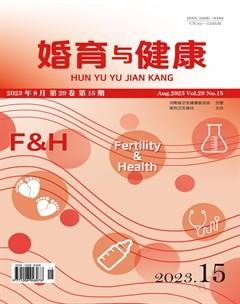经腹腹膜前疝修补术术后肠梗阻1例病例分析
2023-09-25王丽婷原江亮高鹏程
王丽婷 原江亮 高鹏程

【摘要】目的:分析接受腹腔镜经腹腹膜前疝修补术后出现肠梗阻的发病机制、治疗方法及预防方法。方法:回顾性分析我科1例腹腔镜经腹腹膜前疝修补术术后肠梗阻病例,了解肠梗阻形成原因。结果:腹腔镜探查后,发现缝合腹膜的倒刺线留置过长,与小肠肠系膜粘连后形成粘连带,小肠围绕粘连带形成肠扭转,进而导致肠梗阻。结论:腹腔镜经腹腹膜前疝修补术中,应正确使用倒刺线关闭腹膜,关闭腹膜时可以在倒刺线末端打结后再剪断,避免留置线头过短导致脱线。也可将倒刺线固定于脐内侧皱襞上,让脂肪将倒刺线末端覆盖,以降低肠梗阻发生率。
【关键词】腹腔镜;腹股沟疝;经腹腹膜前修补术;并发症;肠梗阻
A case report of intestinal obstruction after transabdominal anterior peritoneal hernia repairsurgery
WANG Liting, YUAN Jiangliang, GAO Pengcheng
Department of general surgery, Jincheng Peoples Hospital, Jincheng, Shanxi 048000, China
【Abstract】Objective:To analyze the pathogenesis,treatment and prevention of intestinal obstruction after laparoscopic transabdominal anterior peritoneal hernia repair.Methods:Retrospective analysis of a case of intestinal obstruction after laparoscopic transabdominal anterior peritoneal hernia repair in our department to understand the causes of intestinal obstruction.Results:After laparoscopic exploration,it was found that the barbed thread for suturing peritoneum was left too long,which formed adhesion with the intestinal mesentery,and the small intestine formed intestinal volvulus around the adhesive band,leading to intestinal obstruction.Conclusion:During laparoscopic transabdominal anterior peritoneal hernia repair,the peritoneum should be closed correctly with the barbed wire.When closing the peritoneum,the end of the barbed wire can be knotted and then cut off to avoid the disconnection caused by too short retained thread. The barbed wire can also be fixed on the medial umbilical fold,allowing fat to cover the end of the barbed wire to reduce the incidence of intestinal obstruction.
【Key Words】Laparoscope; Inguinal hernia; Transabdominal preperitoneal repair; Complication; Intestinal obstruction
1 临床治疗
现病史:患者老年男性,主因“腹腔镜经腹腹膜前疝修补术后1月,腹痛1d”入院。患者1月前因右侧腹股沟斜疝于外院行手术治疗,手术方式为:腹腔镜经腹腹膜前无张力修补术。1d前并未发现诱发因素,为下腹部疼痛,疼痛持续性发作,伴有腹胀、呕吐,其中,嘔吐2次(全部是胃内容物),兼有排气、排便中止。患者就诊于外院行腹部CT检查提示:内疝,未行治疗,为实施规范性诊治则来院接受检查,行腹部CT检查提示:右中下腹腹腔间隙密度增高伴有漩涡征。急诊以“肠扭转”为诊断收入我科,患者就诊时意识清晰,精神状态萎靡,自诉平时睡眠差,饮食差,小便正常,大便未排。
既往史:患者10多年前因双膝关节骨质增生行手术治疗。平时体健。
查体:腹胀,腹壁没有静脉曲张,却可见数个腹腔镜手术瘢痕,无胃肠型或蠕动波。下腹部肌紧张,存在压痛感,没有反跳痛,不能触摸肝脾肋下及包块,墨菲氏征呈(+)性。肠鸣音6~8次/min,未见气过水声、血管杂音。
辅助检查:WBC 9.5×109/L、NEU 9.08×109/L、NEU% 95.6%、CRP 8.48mg/L。
指导患者选择站立位,对其实施腹部平扫,其结果示:肠道有积气;且CT结果示:右中下腹腹腔间隙密度增高伴有漩涡征;对腹主动脉、肠系膜动脉进行彩超检查:肠系膜上静脉扭转征象,肠扭转?
诊断:结合患者的临床表现、体征变化、以往病史、辅助检查,考虑诊断:1.肠梗阻;2.右侧腹股沟疝术后。
治疗:考虑患者肠梗阻可能与腹股沟疝手术有关。和患者及其家属说明具体病情,然后制定相应的治疗方案。
2 术中情况
实施麻醉后,指导患者平躺在手术台中,常规碘伏消毒、铺单,取脐上缘切开皮肤皮下置入10mm戳卡,创造人工气腹,探查可见:右下腹壁腹膜缝合处与小肠系膜形成粘连带,回肠肠管疝入粘连环内,系膜扭转,疝入肠管(见图1)及相应系膜水肿,小肠蠕动正常,腹腔可见约200mL淡血性渗液,术中诊断:小肠系膜扭转、腹内疝,拟行开腹小肠系膜复位术。关掉气腹,撤掉器械,于腹部正中做一个长度约10cm的切口,逐层切开入腹,电刀烧断粘连带,顺回盲部探查将小肠系膜复位,复位过程中见倒刺线末端与肠系膜紧密粘连(见图2),吸出盆腔渗液,并于盆腔放置引流管一根,查并未发现活动性出血,清查医疗器械,逐一缝合切口。手术期间麻醉效果理想,操作順利,出血量少。术后患者及时清醒,并将其安置在病房中观察。
3 结果
术后第1d,除切口疼痛外无明显腹痛、腹胀,无恶心、呕吐;术后第2d,患者排气,进流质饮食;术后第3d,患者排便,进半流饮食;手术后7d,患者身体全面恢复,顺利办理出院手续。
4 讨论
腹股沟疝的手术治疗有两种:传统开刀术与腹腔镜术,腹腔镜手术中经腹腹膜前修补术已经广为普及,许多基层医院也可熟练掌握。腹腔镜术后常见并发症有阴囊血肿、疝复发、假疝囊形成、补片感染、切口感染、切口疝、静脉血栓栓塞症等,术后肠扭转、肠梗阻少见。据报道,TAPP手术后肠梗阻的发生率高于开腹疝修补术后[1]。
TAPP术后肠梗阻的原因主要为,腹膜缺损过大导致肠管疝入腹膜前间隙,疝气钉、倒刺线与肠管或肠系膜粘连。

腹膜缝合的方式包括可吸收线缝合、倒刺线缝合、疝钉固定、胶水固定,许多研究比较了腹股沟疝修补术中不同关腹方式形成的术后并发症。Kapiris等人[2]发现,使用Vicryl缝合线可以减少因腹膜闭合引起的肠梗阻。Fitzgerald等人[3]报道了一例由TAPP术后螺旋钉移位引起的肠梗阻。有研究显示[4]:TAPP疝修补术在实施期间选择的是可吸收线缝合法、倒刺线缝合法、疝钉固定法,三种关闭腹膜方式的短期治疗效果对比差异不明显(P>0.05);而长期治疗效果对比需要进一步评估。疝钉固定法的手术治疗耗时最少,不过其治疗成本偏高;倒刺线缝合法在提高治疗成本的前提下,并没有明显缩短手术操作时间;临床医生需要按照以往的实践经验、患者病情等确定最理想的腹膜关闭方法。尽管TAPP中腹膜闭合的最佳方法仍有争议,但连续缝合法被广泛使用[5-6]。
倒刺线不需要缝合,这简化了腹膜缝合布置并缩短了手术时间。近年来,它们已广泛应用于TAPP[7]。然而,如果使用不当,倒钩可能会附着在相邻的小肠、肠系膜或网膜上,导致肠粘连、肠扭转和肠梗阻等并发症[8]。例如,Tagliaferri等人[9]和Filser等人[10]报道了倒刺线的残余端钩住肠系膜并导致小肠扭转的病例。此外,K?hler等人[11]报道了1例倒刺线与小肠壁紧密粘连导致的肠梗阻。因此,正确使用倒刺线对降低TAPP手术肠梗阻发生率非常重要。
在TAPP术中,应正确使用倒刺线关闭腹膜,关闭腹膜时可以在倒刺线末端打结后再剪断,避免留置线头过短导致脱线。也可将倒刺线固定于脐内侧皱襞上,让脂肪将倒刺线末端覆盖,以降低肠梗阻发生率。
参考文献
[1] BRINGMAN S, BLOMQVIST P. Intestinal obstruction after inguinal and femoral hernia repair: a study of 33,275 operations during 1992-2000 in Sweden[J]. Hernia,2005,9(2):178-183.
[2] KAPIRIS S A,BOOUGH W A,ROYSTON C M,et al.Laparoscopic transabdominal preperitoneal(TAPP) hernia repair: A 7-year two-center experience in 3017 patients[J]. Surgical endoscopy,2001,15(9):972-975.
[3] FITZGERALD H L, ORENSTEIN S B, NOVITSKY Y W. Small Bowel Obstruction Owing to Displaced Spiral Tack After Laparoscopic TAPP Inguinal Hernia Repair[J]. Surg Laparosc Endosc Percutan Tech,2010(20):132-135.
[4] 都敏,唐光华,吴红霞,等.TAPP疝修补术不同腹膜关闭方式的临床研究[J].中国卫生标准管理,2019, 10(17):17-19.
[5] CHIHARA N, SUZUKI H, SUKEGAWA M,et al. Absorbable barbed suture device for laparoscopic peritoneal closure after hernia repair via the transabdominal preperitoneal approach: A single-center experience with 257 cases[J]. Asian J Endosc Surg,2019,12(2):162-166.
[6] ZHU Y,LIU Y,WANG M. A New Suture Technique for Peritoneal Flap Closure in TAPP: A Prospective Randomized Controlled Trial[J]. Surgical laparoscopy, endoscopy & percutaneous techniques,2020,30(1):18-21.
[7] CLAPP B, KLINGSPORN W, LODEIRO C,et al. Small bowel obstructions following the use of barbed suture: a review of the literature and analysis of the MAUDE database[J]. Surg Endosc,2020,34(3):1261-1269.
[8] SARTORI A, DE LUCA M, CLEMENTE N,et al.Small bowel occlusion after trans-abdominal preperitoneal hernia approach caused by barbed suture: case report and review of literature[J].G Chir,2019(40):322-324.
[9] TAGLIAFERRI E M, WONG T S L, ABAD J L, et al.Small bowel obstruction SBO after TAPP repair caused by a self-anchoring barbed suture device for peritoneal closure: case report[J].J Surg Case Rep,2018(7):1-3.
[10] FILSER J, REIBETANZ J, KRAJINOVIC K,et al. Small bowel volvulus after transabdominal preperitoneal hernia repair due to improper use of V-Loc? barbed absorbable wire -do we always “read the instructions first”[J].Int J Surg Case Rep 2015(8C):193-195.
[11] KOHLER G,MAYER F,LECHNER M, et al.Small bowel obstruction after TAPP repair caused by a selfanchoring barbed suture device for peritoneal closure: case report and review of the literature[J].Hernia,2015,19(3):389-394.
